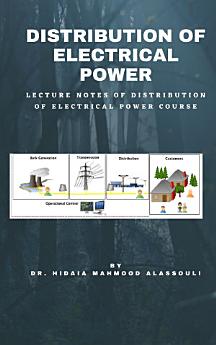Distribution of Electrical Power
О овој е-књизи
The book is divided to different learning outcomes
• CLO 1- Discuss the fundamental concepts related to electrical distribution systems.
• CLO 2- Explain the role of distribution substations and related equipment.
• CLO 3- Outline standard methods for power distribution to consumer installations.
• CLO 4- Apply short-circuit and over-load protection principles for electrical installations
a) CLO1- Discuss the fundamental concepts related to electrical distribution systems.
• Principle of operation of transformers.
• Explain the role of the distribution system in a power system, common distribution system layouts, and common voltages, voltage drops and regulation levels from transmission to distribution.
• Discuss demand, power quality issues, calculate factors affecting design, and interpret the load curve profile for load demand.
• Explain how tariff is calculated and charged consumers
b) CLO2- Explain the role of distribution substations and related equipment.
• Explain the function of the distribution substation in view of distribution system layout
• Explain the use of transmission, grid, primary and distribution substations a power system.
• Explain the use of various types of bus-bar configurations in distribution substations.
• Discuss the use of cabling, transformers, circuit breakers, switches, reclosers, and sectionalisers in a distribution system.
c) CLO3- Outline standard methods for power distribution to consumer installations.
• Discuss commonly used methods for low voltage power supply systems (TN, TN-C, TN-C-S and TT).
• Discuss the main features of a one-line, electrical installation diagram and related symbols.
• Discuss electrical color codes and factors affecting cable installations.
• Design an electrical feeder by (1) selecting the design current, (2) selecting the overload current protection, (3) determining the applicable correction factors, (4) selecting the current-carrying capacity of cable and cable sizing, and (5) calculating the allowable voltage drop in feeder
d) CLO4- Apply short-circuit and over-load protection principles for electrical installations.
• Explain the meaning of overload and over-current and methods of protection
• Discuss the nature of electric shock, need for earthing, earth loop impedance, and principle of protective multiple earthing.
• Explain the principles of fuse/MCB selection in relation to feeder protection under overload and short circuit fault conditions.
• Explain the operation of earth leakage circuit breakers (ELCB) and residual current device (RCD).
О аутору
I am Dr. Hidaia Mahmoud Mohamed Alassouli. I completed my PhD degree in Electrical Engineering from Czech Technical University by February 2003, and my M. Sc. degree in Electrical Engineering from Bahrain University by June 1995. I completed also one study year of most important courses in telecommunication and computer engineering courses in Islamic university in Gaza. So, I covered most important subjects in Electrical Engineering, Computer Engineering and Telecommunications Engineering during my study. My nationality is Palestinian from gaza strip.
I obtained a lot of certified courses in MCSE, SPSS, Cisco (CCNA), A+, Linux.
I worked as Electrical, Telecommunicating and Computer Engineer in a lot of institutions. I worked also as a computer networking administrator.
I had considerable undergraduate teaching experience in several types of courses in many universities. I handled teaching the most important subjects in Electrical and Telecommunication and Computer Engineering.
I could publish a lot of papers a top-tier journals and conference proceedings, besides I published a lot of books in Publishing and Distribution houses.
I wrote a lot of important Arabic articles on online news websites. I also have my own magazine website that I publish on it all my articles: http:// www.anticorruption.000space.
My personal website: www.hidaia-alassouli.000space.
Email: [email protected]







